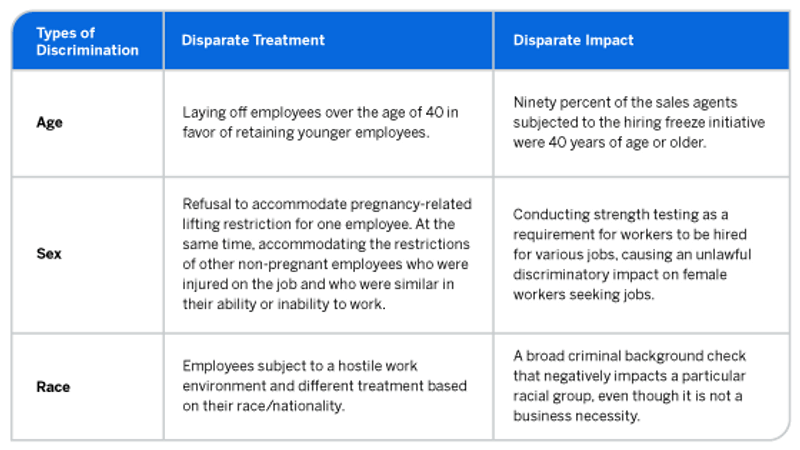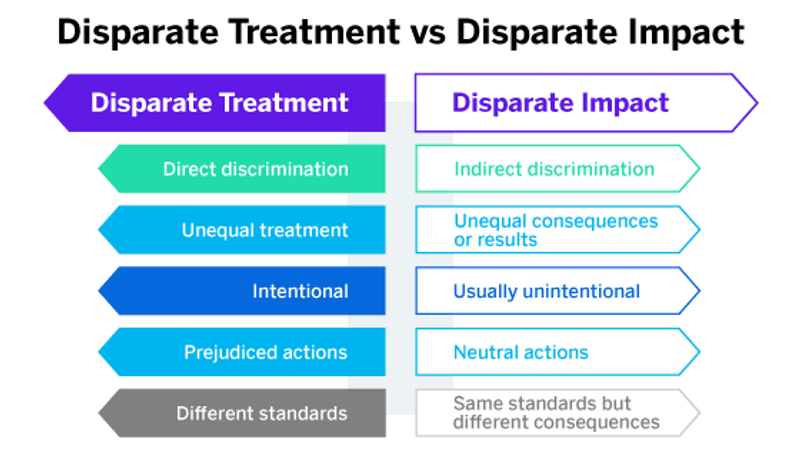Companies want to make sure their employee experiences are positive and inclusive, and leaders may turn to diversity and equality policies, and foster a culture of cooperation and fair treatment. However, despite best efforts, there can be times when discriminatory treatment occurs, and this can be a real problem businesses face.
One such discriminatory treatment is disparate treatment, which is a type of claim that can be bought against an organization. It’s important that companies are aware of disparate treatment, understand examples of what disparate treatment looks like, and what steps to put in place to avoid future lawsuits.
Free eBook: How to apply DEI to your employee experience program
Why is disparate treatment important to your business?
This discrimination type is important as it impacts a person’s civil rights. In the US, under Title VII of the United States Civil Rights Act, employers must treat employees fairly, even if they belong to a protected class.
A protected class is a group of people that share characteristics that could be used as a reason for inequality. The protected classes under the Title VII of the United States Civil Rights Act are race, color, nationality/ national origin, religion, gender and sexual orientation.
If employers discriminate against employees based on a protected class, this gives affected employees grounds to sue the company.
What is disparate treatment?
Disparate treatment is a form of discrimination that can occur in the workplace and is considered as evidence of illegal employment discrimination.
It is intentional discrimination in the form of unequal treatment, which is directly given to an employee. It is due to the employer having prejudiced beliefs, that in turn cause them to apply different standards to different people, based on the class.
Examples of disparate treatments in business
Examples of disparate treatment discriminatory practices in business include:
- Hiring on the basis of strength to favor male gender over female gender employees, even if there is no business necessity in the job for heavy lifting.
- Giving senior positions in a company to male employees, because the long hours of the job are perceived to conflict with female employee childcare arrangements or pregnancy health checks.
- Running criminal background checks is only performed for new hires that come from a particular background, ethnicity, or national origin.

Disparate treatment vs disparate impact
Disparate impact is different from disparate treatment.
While disparate treatment is direct discrimination, disparate impact is indirect discrimination.
- Disparate impact = unintentional discrimination
- Disparate treatment = intentional discrimination
An employer may put in place a rule or practice that is neutral and serves all employees, but it would disadvantage people from a protected class more than others.
In this way, the employer unintentionally impacts protected groups, as the employer hasn’t considered that the same actions could have a negative and unequal consequence on some groups.
For example, implementing and emphasizing a drinking culture to socialize may negatively impact employees that have religions that discourage drinking. By not taking part, they are harmed in their job prospects and company inclusion.

What impact can disparate treatment lawsuits have on your business?
There are many reasons why disparate treatment can affect a business:
- Cost: The expense of being sued can impact the finances of a business, especially if the lawsuit is long
- Reputation: Being involved in proceedings that involve impacting employee civil rights can harm your company’s reputation
- Employee perception: Within a company, the employees can view this as the way that all are treated, which could lead to high attrition rates and poor morale levels.
The knock-on effects of these will reflect negatively on sales, company culture, and employee productivity.
Free eBook: How to apply DEI to your employee experience program
What can employees do?
Any employee or applicant to a company can claim they are a victim of disparate treatment, intentionally discriminated on the basis of race, color, nationality/ national origin, religion, gender, and sexual orientation.
In order for them to make a claim, they must be able to show:
- They are a member of a protected class and the employer knew they were a member of that class
- They were treated differently to other employees based on their belonging to a protected class, because of the employer’s prejudicial views.
- That there were intentionally different standards for them which harmed the employer
(If there is no intent, the employee could bring a case for disparate treatment instead)
In what ways can disparate treatment be shown?
- Refusal to hire: An employer would be in violation of disparate treatment if they choose to discriminate against a protected class. An example of this is when a CV is dismissed from the consideration pool because the name on the CV suggests a non-white-sounding name. This would indicate the applicant belongs to a different nationality. If the employer continues to seek applicants, despite the current applicant being qualified, this could be disparate treatment.
- Poor working conditions: If employers place employees in a hostile working condition, based on their prejudicial views about the protected class they belong to, this is a violation of disparate treatment. The employees may be subjected to ridicule or attacks, or they may be passed over for promotion where no other reason than their protected class membership is the issue.
- Reason to terminate employment: If an employer unfairly fires an employee based on conditions that indicate their protected class membership was the reason, then this is a violation of disparate treatment. For example, if a young person is fired for certain behavior on the job, but older employees do the same and aren’t reprimanded, it could be that the employer prefers workers that are older.
What would happen if you are accused of disparate treatment?
The employer is responsible for producing a legitimate, nondiscriminatory reason in a lawsuit so that they can show that disparate treatment was not given.
The employer then needs to provide evidence of their reason so that they can back up their claim. This is where documentation of actions and reasonings is useful to have, as this can be produced as evidence in court.
It is then over to the employer to prove that this was not the case and that it is pretext, and the true motivation was prejudicial views and rules.
How to avoid disparate treatment at your organization
Prevention is always the best approach to tackling the possibility of disparate treatment.
HR professionals and leaders can work together to prevent this issue from arising by:
- Implementing or reviewing policies: These policies can cover all aspects of company life, from hiring, working conditions, career progression, performance management, and termination. The policies should be reviewed regularly for their emphasis on fair treatment. It is recommended that your legal team be involved so that the policy is within the letter of the law.
- Manager and leadership training: Managers and leaders can be the perpetrators of disparate treatment and they must be made aware of the real issue and risks associated with it. If there are issues, they should be discussed and training should be provided at several stages throughout their career so that this issue is front of mind.
- Focus on Diversity, Equality, and Inclusion (DEI) in the company: If your company does not have a culture of diverse and inclusive thinking, then it’s time to set one up. Having recognition for the diverse and different backgrounds of your employees helps create a safer and more aware organization, which is accepting and supportive of people from protected classes.
The Society for Human Resource Management (SHRM) describes the nine action steps to creating a DEI initiative, which can be a helpful starting resource for employers.

- Create opportunities for communication and feedback: Provide safe channels where employees can give feedback on behavior or whistleblow to senior leaders about their experiences. This can prevent issues from snowballing, allowing leaders and HR to react quickly and resolve possible violations in the making.
- Document your actions: Review the practices regularly to see if employer actions towards employees were justified on non-prejudicial grounds
Related article: The ultimate guide to DEI – 12 steps every organization should take
How can Qualtrics help prevent disparate treatment?
As you build a culture of diversity and inclusion, you will be responsible for shoring up the employee’s lifecycle from start to finish.
Any changes you make, you want to ensure that employees get the message, understand the new information, and act accordingly. This is hard to do individually with large numbers of employees spread across different locations and with different language requirements.
Qualtrics solutions can make this process easier and faster. The one-stop solution keeps track of what is sent, who receives it, and all responses. Language support is included, with easy follow-on and alert set-up, should you need to respond quickly to issues
It can connect easily with existing systems to connect up data and make reporting easy. This is especially useful if you need to prove documentation and a robust system is in place to support against any claim of violation.
And it’s not only useful in reacting to changes in the company. It can help identify issues in advance, by being used as a tool to communicate with your employees directly.
Employees can be asked for their feedback in annual employee surveys, online honesty boxes, satisfaction surveys and employer branding surveys. These can show how employees perceive the real-life conditions they face and give you early understanding so you can take action.
Help your business stand up to this important employment legal issue. Find out more about our Employee Experience solution and get a personalized demo of how it can be used in practice.
Free eBook: How to apply DEI to your employee experience program